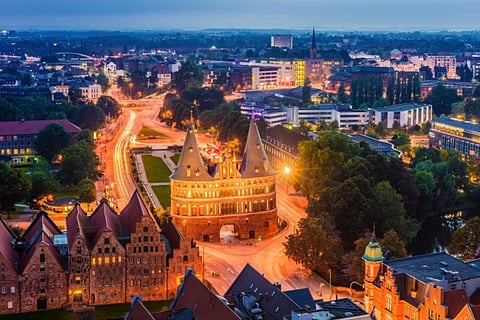
- Destinations
- Experiences
- Stay
- What's new
- Celebrating People
- Responsible Tourism
- CampaignsCampaigns
- SubscribeSubscribe
- Buy Now

Few places in the world can offer a historical journey as captivating and intricate as Germany. The country's rich tapestry of history bears witness to the convergence of diverse cultural influences such as Roman, Celtic, French, Prussian, and many more over the centuries. Germany is where the stories of Europe's past come to life and illuminate the depths of its complex and fascinating history. Here are few cities you must explore for a trip down the past.
Augsburg
Augsburg has always had a certain allure that sets it apart from other cities. Its grand guild houses, stunning fountains, beautiful churches, and the Town Hall create a cityscape that exudes a unique intensity. The city's rich history includes notable periods such as Baroque and Rococo eras and the Art Nouveau movement, which all combine to create a special experience when walking through the city. The magnificent cathedral, with its almost 1,000-year-old bronze doors, and the Basilica of St. Ulrich and St. Afra have been astounding travellers since the High Middle Ages. The city is also the birthplace of Leopold Mozart, the father of Wolfgang Amadeus Mozart, and the two composers are commemorated during the annual Mozart Festival held every May.
Technology enthusiasts will also be fascinated by Augsburg's globally unique water management system, which includes numerous water towers, hydroelectric power plants, magnificent fountains, and watercourses. In 2019, this system was designated a UNESCO World Heritage Site. As the day comes to an end, there is no better way to relax than to enjoy a drink in one of the many charming bars in the Old Town.
Lubeck
As one of the most significant early global trade cities, Lubeck has always been extraordinary. Surrounded by water, the Old Town's seven towers and five main churches bear testament to the city's 1,000-year eventful history. This is a UNESCO World Heritage Site due to the Gothic, Renaissance, Baroque and Classicist buildings, narrow lanes and streets, churches and monasteries, merchants' houses, and fortifications that make up the remarkable whole. The St. Mary's Church is an excellent example of Brick Gothic architecture and has the world's tallest brick vault. The modern MuK music and congress hall, located just a stone's throw away, is the primary venue for the Schleswig-Holstein Music Festival.
Other notable buildings in the Old Town include the Town Hall ensemble, the castle monastery, the Koberg square, the district between St. Peter's Church and the cathedral, the Holsten Gate, the city's most famous landmark, and the Salzspeicher salt storehouses on the banks of the Trave River.
Potsdam
Three hundred years ago, Potsdam underwent a transformation into one of Europe's most magnificent royal cities. The Prussian kings created a Baroque dream in Potsdam and the surrounding areas, commissioning grand monuments to Classicism. The Palaces and Parks of Potsdam, which encompass 150 buildings and cover about 500 hectares of parkland dating from 1730 to 1916, were awarded UNESCO World Heritage status in 1990. St. Nicholas Church, the Lustgarten park, the Old Town Hall, the Barberini Museum, and the reconstructed former City Palace all make for an excellent starting point for a walk at Alter Markt square. Opposite this square lies the Neuer Markt, one of the best-preserved Baroque squares in Europe.
Visitors can enjoy a more laid-back ambiance and lifestyle in the Dutch quarter, with its lovingly decorated courtyards, cafes, offbeat bars, and galleries, accessed through the Nauen Gate. No visit to Potsdam is complete without a trip along the city's waterways on one of the Weisse Flotte steamboats. These vessels go as far as the Glienicke Bridge, which connected Potsdam to Berlin and is where East and West exchanged secret agents and spies until the 1980s.
Würzburg
With a warm and welcoming Franconian charm, Würzburg is a Baroque beauty that captures the heart. The city's diverse architectural wonders, spanning the ages, shape its enchanting skyline. From a distance, the towering spires of St. Kilian Cathedral, the fourth largest Romanesque church in Germany, beckon travellers to explore the city. Notable landmarks include the UNESCO World Heritage site of the Würzburg Residence, adorned with its magnificent Court Gardens and Residence Square, the formidable Marienberg Fortress, and the majestic Old Main Bridge adorned with striking statues of revered saints. Nestled amidst picturesque vineyards and spanning the tranquil banks of the Main River, Würzburg's location alone is a compelling reason to visit.
For a journey into the past, a visit to the Marienberg Fortress is a must. It boasts the largest collection of works by the famed sculptor and woodcarver Tilman Riemenschneider. Meanwhile, the Kulturspeicher building at the old port showcases modern art from the 19th century to the present day, with its 3,500-square-meter museum.
Trier
Trier is a city with a rich and colourful history, shaped by the reigns of Roman emperors, bishops, electors, and ordinary people. The city preserves a plethora of world-class architectural masterpieces and artistic treasures, many of which have achieved UNESCO World Heritage status. The iconic Porta Nigra, the Amphitheatre, and the legendary Imperial Baths, once the relaxation retreats of the Romans, pay homage to Trier's profound classical heritage. The awe-inspiring medieval buildings, such as the oldest church in Germany, St. Peter's Cathedral, and the early-Gothic Church of Our Lady, leave a lasting impression. Every June, the Hauptmarkt square bursts to life with the Old City Festival, a spectacle to behold.
